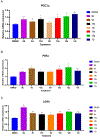Development and pharmacological evaluation of a new chemical series of potent pan-ERR agonists, identification of SLU-PP-915
- PMID: 37421886
- PMCID: PMC10399613
- DOI: 10.1016/j.ejmech.2023.115582
Development and pharmacological evaluation of a new chemical series of potent pan-ERR agonists, identification of SLU-PP-915
Abstract
Estrogen-related receptors (ERR) are an orphan nuclear receptor sub-family that play a critical role in regulating gene transcription for several physiological processes including mitochondrial function, cellular energy utilization and homeostasis. They have also been implicated to play a role in several pathological conditions. Herein, we report the identification, synthesis, structure-activity relationships and pharmacological evaluation of a new chemical series of potent pan-ERR agonists. This template was designed for ERRγ starting from the known acyl hydrazide template and compounds such as agonist GSK-4716 employing a structure-based drug design approach. This led to the preparation of a series of 2,5-disubstituted thiophenes from which several were found to be potent agonists of ERRγ in cell-based co-transfection assays. Additionally, direct binding to ERRγ was established through 1H NMR protein-ligand binding experiments. Compound optimization revealed that the phenolic or aniline groups could be replaced with a boronic acid moiety, which was able to maintain activity and demonstrated improved metabolic stability in microsomal in vitro assays. Further pharmacological evaluation of these compounds showed that they had roughly equivalent agonist activity on ERR isoforms α and β representing an ERR pan-agonist profile. One potent agonist, SLU-PP-915 (10s), which contained a boronic acid moiety was profiled in gene expression assays and found to significantly upregulate the expression of ERR target genes such as peroxisome-proliferator activated receptor γ co-activators-1α, lactate dehydrogenase A, DNA damage inducible transcript 4 and pyruvate dehydrogenase kinase 4 both in vitro and in vivo.
Keywords: 2 5-disubstituted thiophenes; Boronic acid; Estrogen-related receptor; Nuclear receptor; Pan-agonist.
Copyright © 2023 Elsevier Masson SAS. All rights reserved.
Conflict of interest statement
Declaration of competing interest The authors declare the following financial interests/personal relationships which may be considered as potential competing interests:John K Walker reports financial support was provided by National Institutes of Health. Thomas P. Burris reports financial support was provided by National Institutes of Health. John K. Walker has patent #WO2019036562; Heteroaromatics as ERR inverse agonists and their preparation licensed to Myonid Therapeutics. Thomas P. Burris has patent #WO2019036562; Heteroaromatics as ERR inverse agonists and their preparation licensed to Myonid Therapeutics. Carissa Hampton has patent #WO2019036562; Heteroaromatics as ERR inverse agonists and their preparation licensed to Myonid Therapeutics. Keith Haynes has patent #WO2019036562; Heteroaromatics as ERR inverse agonists and their preparation licensed to Myonid Therapeutics. Kristine Griffett has patent #WO2019036562; Heteroaromatics as ERR inverse agonists and their preparation licensed to Myonid Therapeutics. Cyrielle Billon has patent #WO2019036562; Heteroaromatics as ERR inverse agonists and their preparation licensed to Myonid Therapeutics. Sadichha Situala has patent #WO2019036562; Heteroaromatics as ERR inverse agonists and their preparation licensed to Myonid Therapeutics. Founders in Myonid Therapeutics which is trying to develop ERR modulators as novel therapeutics (J.K.W. & T.P.B)
Figures











Similar articles
-
Novel Pan-ERR Agonists Ameliorate Heart Failure Through Enhancing Cardiac Fatty Acid Metabolism and Mitochondrial Function.Circulation. 2024 Jan 16;149(3):227-250. doi: 10.1161/CIRCULATIONAHA.123.066542. Epub 2023 Nov 14. Circulation. 2024. PMID: 37961903 Free PMC article.
-
Synthetic ERRα/β/γ Agonist Induces an ERRα-Dependent Acute Aerobic Exercise Response and Enhances Exercise Capacity.ACS Chem Biol. 2023 Apr 21;18(4):756-771. doi: 10.1021/acschembio.2c00720. Epub 2023 Mar 29. ACS Chem Biol. 2023. PMID: 36988910 Free PMC article.
-
A Synthetic ERR Agonist Alleviates Metabolic Syndrome.J Pharmacol Exp Ther. 2024 Jan 17;388(2):232-240. doi: 10.1124/jpet.123.001733. J Pharmacol Exp Ther. 2024. PMID: 37739806 Free PMC article.
-
ERRγ: a Junior Orphan with a Senior Role in Metabolism.Trends Endocrinol Metab. 2017 Apr;28(4):261-272. doi: 10.1016/j.tem.2016.12.005. Epub 2017 Feb 14. Trends Endocrinol Metab. 2017. PMID: 28209382 Review.
-
Constitutive activities of estrogen-related receptors: Transcriptional regulation of metabolism by the ERR pathways in health and disease.Biochim Biophys Acta. 2015 Sep;1852(9):1912-27. doi: 10.1016/j.bbadis.2015.06.016. Epub 2015 Jun 24. Biochim Biophys Acta. 2015. PMID: 26115970 Review.
Cited by
-
Unlocking therapeutic potential: exploring cross-talk among emerging nuclear receptors to combat metabolic dysfunction in steatotic liver disease.NPJ Metab Health Dis. 2024 Jul 3;2(1):13. doi: 10.1038/s44324-024-00013-6. NPJ Metab Health Dis. 2024. PMID: 40603501 Free PMC article. Review.
-
Orphan nuclear receptor transcription factors as drug targets.Transcription. 2025 Apr-Jun;16(2-3):224-260. doi: 10.1080/21541264.2025.2521766. Epub 2025 Jul 11. Transcription. 2025. PMID: 40646688 Free PMC article. Review.
-
The Estrogen Receptor-Related Orphan Receptors Regulate Autophagy through TFEB.Mol Pharmacol. 2024 Sep 17;106(4):164-172. doi: 10.1124/molpharm.124.000889. Mol Pharmacol. 2024. PMID: 39168657
References
-
- Gallastegui N; Mackinnon JA; Fletterick RJ; Estebanez-Perpina E, Advances in our structural understanding of orphan nuclear receptors. Trends Biochem Sci 2015, 40 (1), 25–35. - PubMed
-
- Horard B; Vanacker JM, Estrogen receptor-related receptors: orphan receptors desperately seeking a ligand. Journal of Mol. Endocrinol 2003, 31 (3), 349–357. - PubMed
-
- Greschik H; Wurtz J-M; Sanglier S; Bourguet W; van Dorsselaer A; Moras D; Renaud J-P, Structural and Functional Evidence for Ligand-Independent Transcriptional Activation by the Estrogen-Related Receptor 3. Mol. Cell 2002, 9 (2), 303–313. - PubMed
-
- Hong H; Yang L; Stallcup MR, Hormone-independent Transcriptional Activation and Coactivator Binding by Novel Orphan Nuclear Receptor ERR3. J. Biol. Chem 1999, 274 (32), 22618–22626. - PubMed
MeSH terms
Substances
Grants and funding
LinkOut - more resources
Full Text Sources
Miscellaneous

